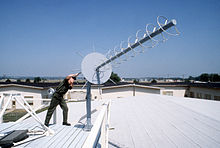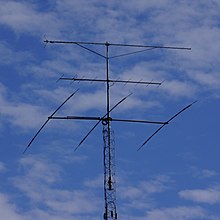Polarization (antennas)
In antenna technology, the term polarization denotes the direction of the electrical field component of an electromagnetic wave. A distinction is made between the linear and the circular polarization of an antenna. In the case of stretched antennas such as dipole antennas or self-radiating transmission masts , the polarization direction corresponds to the direction of the radiator. With the ferrite rod antenna , the polarization direction is perpendicular to the extension of the ferrite rod.
Linear polarization
In the case of a linear polarization, the directions of the electric and magnetic field components are temporally and spatially constant, provided no peculiarities occur which can change the direction. In principle, the polarization changes through transmission or reflection in connection with conductor pieces inclined to the polarization plane or in the ionosphere in connection with magnetic fields. Further examples are circulators and the Faraday effect .
There are two main forms of polarization for terrestrial broadcasters :
- the vertical polarization with an electric field perpendicular to the earth's surface,
- the horizontal polarization with an electric field running parallel to the earth's surface.
Vertical polarization
With vertical polarization, the electric field runs perpendicular to the earth's surface.
For radio transmitters in the medium and long wave range, vertical polarization is used because this is the easiest way to provide ground wave coverage and to achieve omnidirectional radiation . A flat radiating, horizontally polarized antenna would have to be set up at a great height (typically half a wavelength, i.e. 100 m or more) between at least two masts and would have the disadvantage of an undesirable directional effect. Moreover, which is path loss of vertically polarized ground waves lower in this frequency range because few vertical absorbers exist sufficient height.
Horizontal polarization
With horizontal polarization, the electric field runs horizontally to the earth's surface.
In the VHF range (radio, television), horizontal polarization is preferably used for analog transmission, because here the path attenuation and delay time distortion due to reflections and scattering are lower. The exception to this is cellular communications because horizontally polarized cellular antennas are difficult to achieve. With the digital transmission method DAB , vertical polarization is preferred, since reflections and scattering can be better compensated by the digital signal processing . In DVB-T there is currently no clear preference for polarization.
In geostationary satellites such as Astra , the transmitters for neighboring channels are alternately polarized vertically and horizontally in order to minimize mutual interference in the common parabolic antenna.
Measurement
The direction of polarization can be checked experimentally:
- If the wavelengths are sufficiently short, use a rotatable dipole or wire grid polarizer .
- At long wavelengths it is easier to measure the orthogonal alternating magnetic field with a magnetic antenna in the form of a ferrite rod antenna or a loop antenna .
The test is carried out in such a way that the orientation for extinction (signal zero) is determined - then the dipole antenna or the wires of the grating are exactly transverse to the direction of polarization. The magnetic antenna then points exactly in the direction of the electric field lines.
Circular polarization

With circular polarization , the field strength vector rotates clockwise or counterclockwise perpendicular to the direction of propagation Z (clockwise or counterclockwise circular polarization). A circular polarization arises e.g. B. by two offset by 90 ° and fed by 90 ° phase-shifted, linearly polarized antennas. If the amplitudes of the two linear components are not the same, an elliptical polarization occurs .
In the ionosphere and when reflecting off objects, the direction of rotation is often reversed, which can lead to attenuation. If these vary over time, polarization fading occurs .
For optimal reception, the transmitting and receiving antennas must have the same direction of polarization rotation. If this is not the case, there will be considerable attenuation of the signal, in practice between 20 and 30 dB. Due to this fact, one can suppress both atmospheric disturbances and certain electronic disturbances by consciously changing the polarization. If there is an antenna with linear polarization on one side and one with circular polarization on the other side, the loss is 3 dB.
Application of circular polarization
- If it is not exactly known which position two corresponding antennas are in relation to each other (for example, because an antenna is staggering somewhere in the room), the circular polarization still enables a stable connection, since the axial angle between the transmitting and receiving antenna is not here Has more meaning.
- Disturbances of a reconnaissance radar device caused by precipitation can be reduced by a circular polarization. As parts of the reflected energy from different distances overlap and thus partially cancel each other, a reduction in the backscattering cross-section of the diffuse object is brought about, which is theoretically even zero. In bad weather, these radars will therefore preferably use circular polarization.
- When examining the ionosphere with the help of circularly polarized short-wave radiation, the sense of rotation decides whether waves should be reflected or absorbed to the ground, because the earth's magnetic field ensures selective absorption .
literature
- Eberhard Spindlert: The great antenna book. 11th edition, Franzis-Verlag GmbH, Munich, 1987, ISBN 3-7723-8761-6
- Stratis Karamanolis: All About CB A manual for the CB radio operator. 2nd edition, Karamanolis Verlag, Putzbrunn, 1977
- Hans Lobensommer: Handbook of modern radio technology. 1st edition, Franzis Verlag GmbH, Poing, 1995, ISBN 3-7723-4262-0
- Gregor Häberle, Heinz Häberle, Thomas Kleiber: Expertise in radio, television and radio electronics. 3rd edition, Verlag Europa-Lehrmittel, Haan-Gruiten, 1996, ISBN 3-8085-3263-7
Individual evidence
- ↑ According to the convention of the left or right hand rule, this example of circular polarization is a right-handed helix (comparable to a screw with a right-hand thread!): The shown wave is therefore circularly polarized right-handed.


